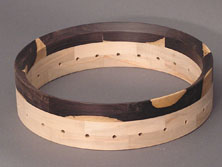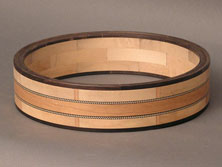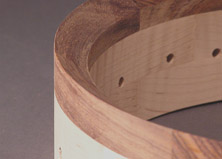Wood Tonering Variables
This page is devoted to comparing rims. The idea is to isolate as much as possible, single differences between rims in order to discover principles for creating or modifying tone. All recordings were done with the aid of a rim tester which allows me to record rims before they are made into a complete banjo.
Cherry vs. Walnut... Same banjo design.
https://www.youtube.com/watch?v=UhomrN3MZJU&t=20s
| RIM 1 | RIM 2 | VARIABLE TESTED |
|
VARIABLE: 0.75 inches thick |
.VARIABLE: 0.60 inches thick |
Wall Thickness: This is the same rim tested twice at two different thicknesses. After finishing this rim I was not satisfied with the tone, so I put it back ton the lathe, thinned the walls and tested it again. This is an 11" diameter rim. This rim was overly bright and had an annoying jangling sounds in the treble notes. Thinning the walls was a great improvement. The improvement is more evident in the Flop Eared Mule recordings CONCLUSION: In this case thinner walls cut treble and improved mid tones and bass tones.
|
VARIABLE: Med. Density Tonering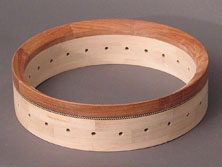 Arkansas Traveler | Flop Eared Mule |
VARIABLE: High Density Tonering |
Tonering Density: The body of these two rims were made from the same board of soft maple. Both are 11" diameter rims.
Rim 1 features a tonering of medium density Grenadilla (Platymiscium ycatanum) while Rim 2 features a tonering of high density African blackwood (Dalbergia Melanoxylon). CONCLUSION: The tones are similar, but the blackwood has more presence and balance. |
VARIABLE: Thick Tonering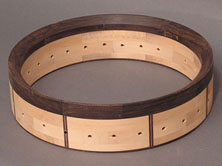 Arkansas Traveler | Flop Eared Mule |
VARIABLE: Thin Tonering |
Tonering Thickness: The body of these two rims were made from the same board of Timeless Timber maple. Both are 12" diameter rims.
Rim 1 features a 3/4" high tonering of African blackwood (Dalbergia Melanoxylon) Rim 2 has the same material tonering, but only 3/8" high. CONCLUSION: The thinner tonering has a more pronounced treble response. Both have similar bass and midtone response. |
VARIABLE: Thick Leading Edge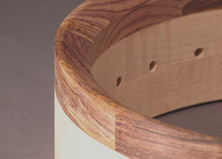 Flop Eard Mule |
VARIABLE: Thin Leading Edge |
Leading Edge Thickness: These rims are made from the same board of curly maple and turned to the same dimensions. The two cocobolo tonering was turned so that the one rim has a thick leading edge of about 1/8" wide and the thin leading edge was about 1/16" wide..
CONCLUSION: The rim with the thicker leading edge.had slightly more pronounced mid tones and a somewhat richer tone overall, however the rim with the tinner leading edge seemed a littlle more balanced. This may be by virtue of the fact that the tone of the wound string was the same for both rims, but the treble was dampened a bit on the rim with the thick leading edge. The recordings exaggerate the effect.. The total difference was subtle. |

